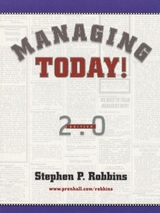
Managing Today!
Prentice Hall (Verlag)
978-0-13-803933-2 (ISBN)
- Titel erscheint in neuer Auflage
- Artikel merken
(NOTE: Chapters conclude with Summary, Review and Discussion Questions, Two Cases and Skill Exercises.) I. INTRODUCTION. 1. Welcome to the Changing World of Work. The New Economy. The New Organization. The New Employee. 2. Managing Organizations and People: Who, What, and Why? Managers and Their Terrain. Multiple Perspectives on What Managers Do. Assessing Managerial Effectiveness. Coming Attractions: A Guide to the Book. II. DECISION AND MONITORING SYSTEMS. 3. Making Decisions. How Should Decisions Be Made? Who Should Make Decisions? How Are Decisions Actually Made in Organizations? What Can Managers Do to Improve Their Decision Making? 4. Assessing the Environment. Defining the Environment. Major Sources of Environmental Uncertainty. Environmental Scanning. Environmental Scanning Tools. Ethical Issues in Environmental Scanning. Strategies for Managing the Environment. Contemporary Organization-Environment Issues. 5. Planning Systems. What is Planning? Types of Plans. Planning in an Uncertain Environment. The Place to Start: Defining an Organizations Purpose. Creating a Strategy. Implementing a Strategy. Ethics of Strategy: How Far is Too Far? Project Management: A Tool for the 90s. Entrepreneurship: A Special Case of Strategic Planning. Objectives: Their Use and Misuse in Planning. 6. Evaluating Performance Through Control Systems. The Control Process. What Managers Seek to Control. How MIS is Changing Control Systems. The Downside of Controls. Control Tools. III. ORGANIZING TASKS AND SHAPING THE ORGANIZATIONS CULTURE. 7. Organization Design: The Efficiency-Flexibility Dilemma. What is Organization Structure? The Contingency Approach to Organization Design. The Evolutionary Approach to Organization Design. 8. Technology and the Design of Work Processes. Technology and Productivity. Operations Technology. Information Technology. Technology and Worker Obsolescence. Work Design. 9. Managing Human Resources. Managers and the HR Department. The Human Resource Management Process. The Regulatory Environment: What Laws and Regulations Shape HRM Practices? Human Resource Planning: Whats Our HRM Needs? Recruitment: Where Do Managers Find Qualified Job Candidates? Selection: How Can Managers Choose the Best Qualified Job Candidate? Training: How Can Managers Insure Employee Skills Are Current? Performance Appraisal: Whats the Best Way to Evaluate an Employees Performance? Decruitment: What Options Exist to Handle Overstaffing? Contemporary Issues in HRM. 10. Understanding Groups and Developing Effective Teams. Groups vs. Teams. Basic Group Concepts. What Explains the Recent Popularity of Teams? Types of Teams. Creating High- Performance Teams. Transforming Individuals into Team Players. 11. Creating and Sustaining the Organizations Culture. What is Organizational Culture? How is Culture Created? How Do Employees Learn Their Organizations Culture? How Do You Read an Organizations Culture? Techniques for Managing an Organizations Culture. Threats to Diversity: The Downside of Strong Cultures. IV. LEADING AND EMPOWERING PEOPLE. 12. Understanding the Basics of Human Behavior. Personality: Classifying Individual Differences. Perception and Attributions: Interpreting the World Around Us. Expectations: What You See Is What You Get. Attitudes: Feelings Influence Behavior. Learning: How People Adapt. Cultural Differences in Human Behavior. 13. Work Motivation and Rewards. Some Popular Myths About Motivation and Rewards. Defining Motivation. Basic Motivation and Reward Issues. An Integrative Model of Motivation. Contemporary Applications. 14. Basic Issues in Leadership. What is Leadership? Identifying the Basic Issues in Leadership. Leadership Effectiveness. Leader Characteristics and Style. Follower Characteristics. Leader Behavior. Leadership Context. The Leadership Journey: Where Weve Been. 15 . Leadership Issues for the 21st Century. Creating Transformational Leaders. Contemporary Leadership Roles. The Gender Issue: Do Men and Women Lead Differently? The Ethics Issue: Is There a Moral Dimension to Leadership? Finding and Creating Effective Leaders. 16. Developing Interpersonal Skills. The Importance of Interpersonal Skills. Interpersonal Communication. Conflict Management Skills. Negotiation Skills. Delegation Skills. Counseling Skills. Politicking Skills. V. ORGANIZATIONAL RENEWAL. 17. Managing Change: Revisiting the Changing World of Work. The Changing World of Work Revisited. Resistance to Change. Managers as Change Agents. Managing Planned Change. What Can Managers Change? Techniques for Changing People. Contemporary Issues in Managing Change. Appendix A: The Historical Roots of Current Management Practice. Appendix B: Scoring Keys for 'Building Self-Awareness' Boxes. Glossary. Index.
| Erscheint lt. Verlag | 18.12.1996 |
|---|---|
| Verlagsort | Upper Saddle River |
| Sprache | englisch |
| Maße | 203 x 253 mm |
| Gewicht | 1061 g |
| Themenwelt | Wirtschaft ► Betriebswirtschaft / Management ► Unternehmensführung / Management |
| ISBN-10 | 0-13-803933-X / 013803933X |
| ISBN-13 | 978-0-13-803933-2 / 9780138039332 |
| Zustand | Neuware |
| Haben Sie eine Frage zum Produkt? |
aus dem Bereich



